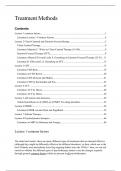Summary
Summary Lectures and Articles Introduction to Treatment Methods - Grade 9
- Course
- Institution
This is a summary for the course Introduction to Treatment Methods. I used both information from the lectures ( = main part) and information from the articles in the summary. I got a 9 on the exam using this summary.
[Show more]



